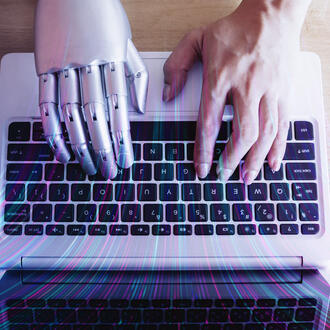Credit: Ivan Bajic / iStock
There’s been widespread concern about robots in workplaces, particularly robots replacing human workers. These concerns have been bolstered by research, such as a study that found industrial robots negatively impact jobs and wages.
But it doesn’t have to be this way, according to MIT professor and roboticist Julie Shah. Her research focuses on creating robots that augment human capabilities and enhance human well-being, instead of replacing humans.
“This is about making robots that are intelligent enough to collaborate with us, to make us better and smarter,” Shah said in June at the EmTech Next Conference hosted by MIT Technology Review.
Collaborative robots — often called cobots — are a fast-growing segment of the industrial robotics market, and are often used in manufacturing. They work directly with human workers.
Because collaborative robots have the potential to improve worker well-being and productivity without taking away jobs, it’s important to spread their benefits widely, Shah, the co-author of “What To Expect When You're Expecting Robots,” said. Yet so far the benefits of cobots have not been distributed evenly, with the cost and skills involved with integration into the workplace preventing smaller firms from adopting them.
Shah outlined the main barrier to collaborative robot use, and why changing how robots are programmed and integrated can lead to broader adoption.
Integration is a challenge, especially for smaller companies
Small and medium firms — companies that employ fewer than 500 workers — make up 98% of manufacturing jobs in the United States, Shah said. These companies employ more than five million workers, and they’re less likely to have robots than larger companies.
While research has found there is one robot for every manufacturing firm in the U.S., these robots are more likely to be found in large firms, particularly in the automotive, electronics, and metal products industries, Shah said. This is a concern because adoption of new technologies leads to improved performance and competitiveness.
Integrating robots into a production or manufacturing line is the main barrier to adoption, Shah said. The cost of a robot alone is a small fraction of the overall cost of integrating it into a workflow, Shah said — integration generally costs four to five times the cost of the actual robot.
Even small changes to a manufacturing line or process are often time-consuming and expensive, and many companies have to turn to outside help for the integration process. “It can be very difficult for small and medium firms to take this work in-house because of the technical expertise required for programming these robots’ systems. And the advances in technology have not addressed this problem,” Shah said.
Related Articles
Integration is further hindered by a lack of standardization of both hardware and software, with each system requiring different knowledge and expertise.
With most robots, integration requires experts who may not understand the workflow, Shah said. Integration efforts that center on workers often lead to more successful outcomes, but workers with domain expertise — line workers and shop floor workers, for example — don’t typically have highly technical skills to program robots.
“Robots are designed to be programmed by people that understand robots,” Shah said.
The way forward: collaborative robots programmed by domain experts
A better approach centers on humans, with domain experts learning to work with collaborative robots, Shah said. According to those she and her team interviewed, the ultimate goal of technology is not a lights-out factory. “A lights-out factory is one that’s not innovating,” she said.
“The role of the human is not in just programming a robot, amending it, and then letting it run open loop,” she said. “A human at the center of the innovation process is really, really key.”
Part of this solution includes switching the current paradigm, which has an automation expert at the center of the process, getting input from a domain expert to program a robot. Instead, the domain expert can teach and train a robot to do a task, as they would with a human counterpart. Robots that can be reconfigured and reprogrammed are also beneficial given the high cost of integration.
The end result would be a robot that doesn’t just complete rote tasks and approach a problem using an inflexible step by step process. Instead, collaborative robots could adapt to what a human is doing, avoiding the potential for a “freezing robot that just sits there and waits for a person to get out of the way.”
For example, a robot programmed to make a meal of sandwiches and juice would traditionally be given step-by-step instructions to first make sandwiches, then wrap them, and then pour juice.
But a robot programmed to help a human make a meal might need to do things out of order and react to what the human is doing. “We want the robot to be a partner in this process — to ask questions, to show rollouts, to show examples, to make queries, to refine its own understanding of that task in collaboration with a person,” Shah said.
This process would allow human workers to offload easier tasks and decisions to robots so humans can focus on more ambiguous, challenging things.
“A key approach in our work here is to be very intentional and very thoughtful about how we define the value of this technology, and the positive outcome of the technology, and not just to aim to replace,” Shah said.
Read "The State of Industrial Robots"



